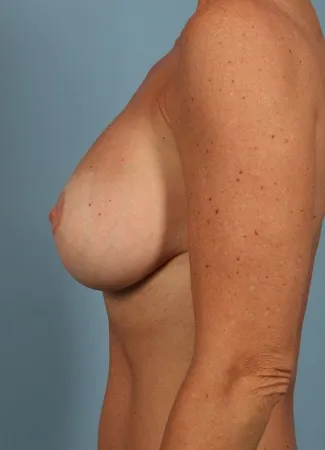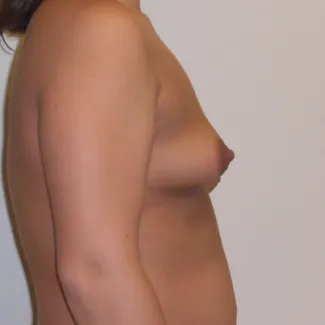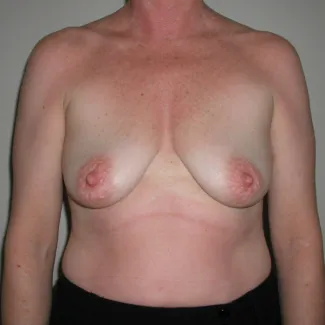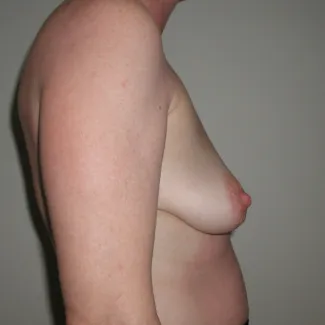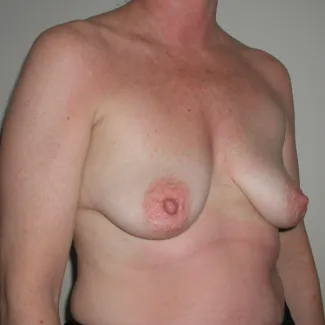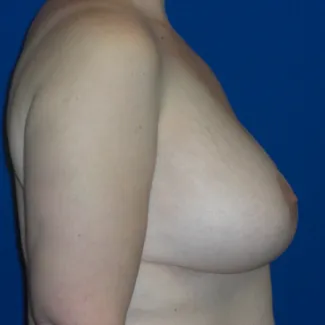Breast Augmentation with Lift
Breast augmentation (enhancement using implants) may be right for you if you are uncomfortable with the size of your breasts. Maybe your breasts never developed to the size you would like, or maybe you lost breast volume after childbearing or breastfeeding. Or maybe you've lost a lot of weight and your breasts have gotten smaller as part of that process. Or maybe your breasts developed unevenly, and you have one that is smaller than the other. You are probably a good candidate for breast augmentation using implants if you fit any of these descriptions. But you may need to add a lift to your augmentation procedure if your breasts also sag or your nipples are much lower than you would like.
Please know that implants do not lift the breasts; they just fill loose skin and make the breast fuller. If your nipples are positioned too low on your breasts now, they will still be too low after augmentation alone. A lift is needed to correct nipple position, in most cases.
There is also a widespread myth that using a larger implant will prevent the need for a lift. This is not true. A bigger implant will just give you bigger breasts and will lead to more skin stretching over the long-run.
The consultation time is meant to be comfortable and educational. We want you to feel completely informed, so you can make your own personal best decision.
See the Possibilities
Before & After
- Breast Lift with Implants
Things You Need to Know
Have Questions?
-
Who is right for breast augmentation with a lift?
Who is right for breast augmentation with a lift?
Breast augmentation (enhancement using implants) may be right for you if you are uncomfortable with the size of your breasts. Maybe your breasts never developed to the size you would like, or maybe you lost breast volume after childbearing or breastfeeding. Or maybe you’ve lost a lot of weight and your breasts have gotten smaller as part of that process. Or maybe your breasts developed unevenly, and you have one that is smaller than the other. You are probably a good candidate for breast augmentation using implants if you fit any of these descriptions. But you may need to add a lift to your augmentation procedure if your breasts also sag or your nipples are much lower than you would like. Please know that implants do not lift the breasts; they just fill loose skin and make the breast fuller. If your nipples are positioned too low on your breasts now, they will still be too low after augmentation alone. A lift is needed to correct nipple position, in most cases. There is also a widespread myth that using a larger implant will prevent the need for a lift. This is not true. A bigger implant will just give you bigger breasts and will lead to more skin stretching over the long-run.
-
What to expect during your consultation
What to expect during your consultation
When you contact our office for a consultation regarding any surgery using breast implants, we will enroll you in EMMI, a free online educational program regarding breast implant surgery. You can go through the EMMI program at home, at your leisure, prior to your consultation. EMMI will give you a good baseline of information related to implants and implant surgery and will allow you to have a very informed conversation with Dr. Kavali during your consultation. After you arrive at our office, you’ll first meet with one of Dr. Kavali’s Physician Assistants. They will begin the consultation process by reviewing your medical history, establishing your goals for the surgery, and by taking relevant photographs for your medical record. Dr. Kavali will complete the consultation process by meeting with you to personally hear about your goals for surgery. She will ask about your desired breast size and anything else related to the appearance of your breasts that you feel is important. This conversation will help Dr. Kavali understand your expectations and determine whether they can realistically be met. Dr. Kavali will examine your breasts. She will be looking at the size and shape of your breasts, the quality of your skin, and the location of your nipples and areolas (the pigmented skin surrounding the nipples). If your breasts droop, she may recommend a breast lift along with the breast augmentation. The consultation time is meant to be comfortable and educational. We want you to feel completely informed, so you can make your own personal best decision. There are some questions that commonly arise during the consultation process, so we’ve included them here.
-
Do implants cause breast cancer?
Do implants cause breast cancer?
There is no scientific evidence that breast augmentation increases the risk of breast cancer. The presence of breast implants, however, makes it more technically difficult to take and read mammograms. This may be a special consideration for women who perhaps are at higher risk for breast cancer because of their family history or other reasons. Placement of the implant underneath the pectoralis muscle may interfere less with mammographic examination, but other factors may also need to be considered with regard to implant placement. Dr. Kavali will discuss this with you.
-
Should I lose weight first?
Should I lose weight first?
If you are planning to lose a significant amount of weight, be sure to tell Dr. Kavali. She may recommend that you stabilize your weight prior to undergoing surgery.
-
What if I want to have a child in the future?
What if I want to have a child in the future?
If you think that you may want to become pregnant in the future, you should mention this to Dr. Kavali. Pregnancy can change breast size and shape in an unpredictable way and could affect the long-term results of your breast augmentation. There is no evidence that breast implants will affect pregnancy or your ability to breast-feed.
-
What decisions have to be made for breast augmentation and breast lift surgery?
What decisions have to be made for breast augmentation and breast lift surgery?
Generally, you and Dr. Kavali will need to make five basic decisions before you have breast augmentation surgery with a breast lift: 1. What type of implant to use 2. Where to place the implant 3. How to get the implant into place 4. What size implant to use 5. What type of lift to have
-
What type of implant should I choose?
What type of implant should I choose?
With the FDA’s approval of silicone gel implants in November of 2006, women can now choose between saline and silicone implants. Dr. Kavali participates in two implant post-approval studies, called BIFS (Breast Implant Followup Study) and PAS (Post Approval Study). These studies are important because they allow us to continue to collect data related to breast implants and their safety. There is financial consideration offered for study participants and participation is completely voluntary. Dr. Kavali will talk to you about these studies and how you may participate. In general, silicone implants have a more natural look and feel than saline implants. Silicone implants also have a lower risk of wrinkling and rippling than saline implants. Saline implants are still a fine option, though. You’ll be able to see and feel both types of implants during your consultation. You’ll also have a lot of information from the EMMI educational program, and Dr. Kavali will help you make the final decision that’s right for you.
-
Where should I have my implant placed: over or under the muscle?
Where should I have my implant placed: over or under the muscle?
There are good reasons for placing an implant below the muscle—there’s less wrinkling and rippling, there may be a lower risk of capsular contracture (hardening of scar tissue around the implant), and there may be a more natural breast shape and less breast droop over the years. There are also good reasons to place an implant above the muscle. If you do a lot of chest exercises and don’t want to feel the implant move, you should consider placing the implant above the muscle. If you have a small amount of breast droop now, but don’t really need a formal breast lift, you might have the implant placed above the muscle to give it a better shape. Dr. Kavali will help you decide which placement option is right for you.
-
Where should my incision be placed?
Where should my incision be placed?
Incisions for breast augmentation can be made in the crease under the breast (inframammary incision), around the lower edge of the areola (periareolar incision) or in the armpit (axillary incision). In general, silicone implants require incisions that are a little longer than the incisions for saline implants. This is because saline implants are filled after they are in place, but silicone implants are pre-filled before placement. All the incisions tend to heal quite well. If you need a lift, your incision type may be a circle around the areola. Or your incision might be a lollipop-type scar (around the areola, then down the center of the breast). Dr. Kavali will discuss with you in detail which one she thinks you need and why.
-
What size should I choose for my breast implants?
What size should I choose for my breast implants?
The question of implant size is nearly impossible to answer before your consultation. Certainly, you should look at before-and-after photos to get an idea of what you like. However, it’s important to realize that there are many variables that affect what implant size will work best for you—your starting breast size, what size you want to be, your ribcage width, and your starting breast width, for example. Dr. Kavali takes your measurements, then chooses a range of implant sizes that will work for you. From there, you make the final decision by actually trying on the implants in the office. Be sure to bring a bra that you want to be able to wear after you have your surgery. It should have no padding, and it should be a full-coverage cup (not a demi-cup).
-
What are the risks of breast augmentation surgery?
What are the risks of breast augmentation surgery?
Thousands of breast augmentation surgeries are done each year, and most go well with no major problems. But problems certainly can occur, as with any surgery. Some of the potential complications include reactions to anesthesia, blood accumulation that may need to be drained surgically, and infection. Although rare, an infection that does not get better with appropriate treatment may require temporary removal of the implant. Changes in nipple or breast sensation may result from breast augmentation surgery, although they usually are temporary. When a breast implant is inserted, a scar capsule forms around it as part of the natural healing process. The capsule may sometimes tighten and compress the implant, causing the breast to feel firmer than normal. Capsular contracture can occur to varying degrees. If it is severe, it can cause discomfort or changes in the breast’s appearance. In such cases, more surgery may be needed to modify or remove the scar tissue, or perhaps remove or replace the implant. Breast implants are not lifetime devices and cannot be expected to last forever. If a saline-filled implant breaks, its contents are harmlessly absorbed by the body within hours. A definite change in the size of the breast is clearly noticed. Rupture can occur as a result of trauma to the chest, but more commonly it occurs spontaneously with no apparent cause. Surgery will be required to replace the implant, if desired. When you have your regular mammograms done, you will need to tell the technician that you have breast implants. Additional views of your breasts will need to be taken. Dr. Kavali, in some instances, may recommend other types of examinations such as ultrasound or magnetic resonance imaging (MRI). It is possible that the presence of breast implants could delay or hinder the early detection of breast cancer. It is important for you to know that no implant has been linked conclusively to any significant disease in humans.
-
How long will my results last?
How long will my results last?
Except in the event of implant deflation requiring surgical replacement with a new implant, the results of your breast augmentation surgery will be long-lasting. However, gravity and the effects of aging will eventually change the size and shape of every woman’s breasts. You may never need any additional breast shaping surgery, or you may do well with a touch-up breast lift at some time. Once all your questions have been answered during your consultation, you’ll meet with Ali, our Patient Coordinator, who will put together the financial and scheduling information you’ll need. We never want you to feel pressured to schedule any surgery. Dr. Kavali prefers that you gather all the information you need and take all the time you need to feel comfortable with your decision to proceed. Once you are ready to schedule your surgery, just let us know. We’ll coordinate a surgery date with you, then we’ll see you again for your preoperative appointment, which will take place a couple of weeks before your surgery date. Of course, we know that many people (like our out-of-state clients) have special circumstances that may require their preoperative appointment to take place closer to the surgery date, and we’re happy to oblige. On the morning of surgery, Dr. Kavali will meet with you again to confirm your final implant choice. You’ll be able to go home the same day as your surgery. Your stitches will be under the skin, and they will dissolve, so you won’t need to have any stitches removed. There will be no drains, except in some very special circumstances (you’ll know before your surgery). Most women are able to drive after only a few days, and most women are able to return to a desk job within a few days as well. More strenuous jobs require more time off, usually not more than a week or two.
-
DIAMOND GLOW IS HERE! THE BEST SOLUTION FOR HEALTHY, VIBRANT, REJUVENATED SKIN
- Diamond Glow (formally Dermalinfusion) is an advanced skin-resurfacing treatment that combines exfoliation, extraction, and infusion of condition-specific serums to improve skin health, function and appearance.
- A patented, non-invasive treatment, Diamond Glow is fully customizable and the perfect solution to address a wide variety of skin concerns and conditions from head-to-toe and is suitable for all skin types and tones.
- Leave feeling rejuvenated at a very reasonable price point
- Dr. Kavali loves her results! (see Instagram @drkavali)
- Call 404-250-3333 today or email info@drkavali.com to make an appointment
-
- Allergan's Allē Program is the rewards program preferred by Kavali Plastic Surgery
- To get the maximum benefits and savings from all of Allergan's products, we recommend downloading the app.
- Often, Allergan sends offers to you directly through the app.
- Click the buttons below to get the app
- Log in to your account and come see us to apply the savings!
- If you have trouble please come on in and we will gladly help :-)
-
That's right, we can now treat your spider veins here at Kavali Plastic Surgery! Our own Stephanie Parker, PA-C has 8 years of vascular treatment experience and is ready to help. Call or email us for more info: 404-250-3333 or info@drkavali.com


See the Future You
Vectra 3D Imaging
If you’ve been thinking about plastic surgery, but you’re worried about what your results might look like, we have something to put your mind at ease.It’s called Vectra 3D Imaging. And it can help you visualize your potential results before you ever commit to having surgery. It can help you make a more informed decision about procedures involving your face, breasts, or body.
Learn More About Our 3D Imaging






